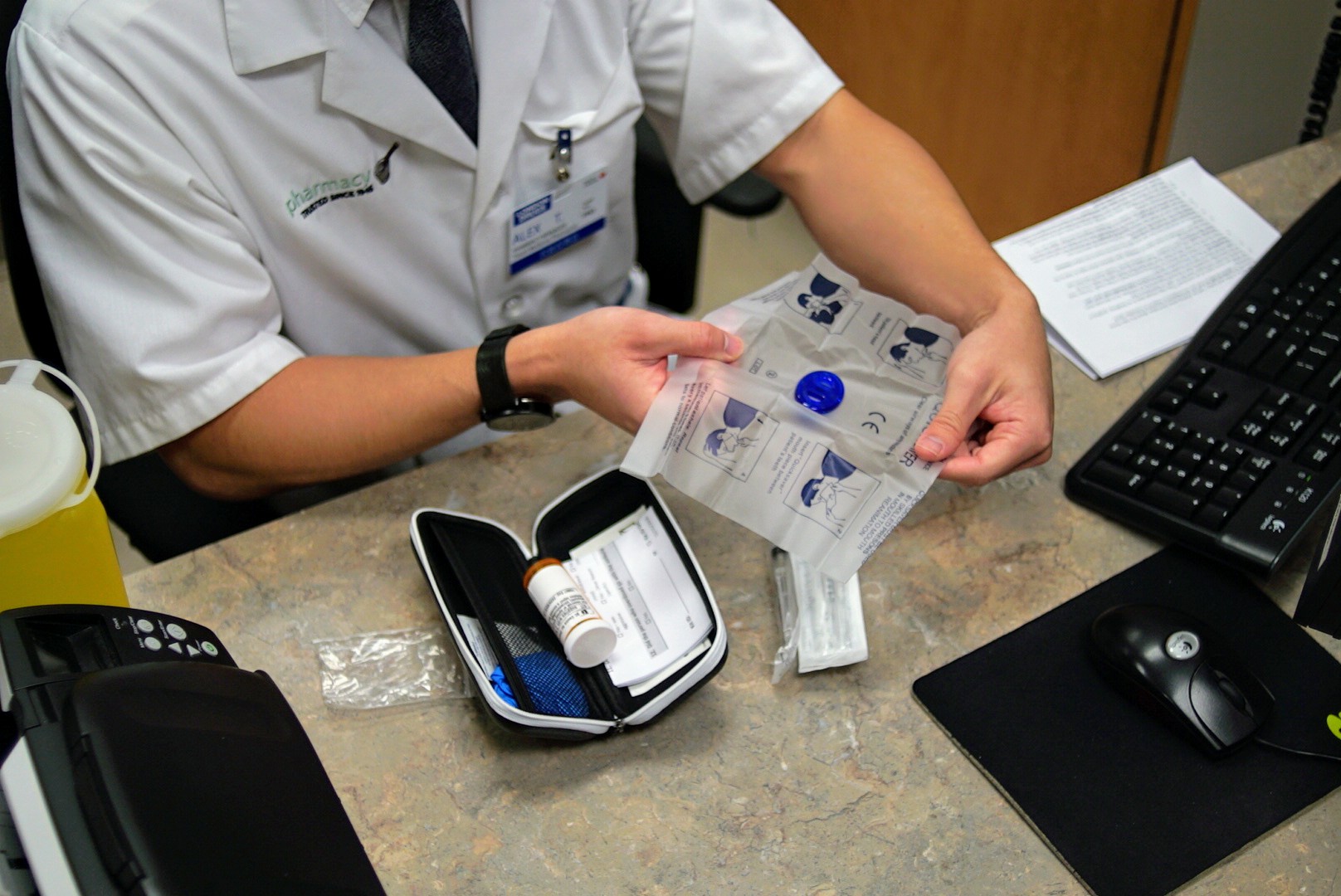The summer of 2018 saw a flurry of legislative efforts to curb the opioid epidemic that reached a record high of 72,000 victims in 2017.[1] On August 16th, 2018, President Trump asked Attorney General Jeff Sessions to bring a “major lawsuit” to opioid-producing drug companies.[2] On August 22nd, Sessions announced a “warning” to opioid distributors, black market dealers and licensed pharmacists alike.[3] This continued the trend of government officials calling to change how easily Americans can acquire narcotics. Most of this legislative effort has been aimed at reducing, or even halting, the prescription of narcotics to the general population. However, the question remains as to whether prescription monitoring is the best way to fight this epidemic. A more effective use of government money would be the creation of programs to assist affected families, communities, and individuals, rather than punishing suppliers.
Bills such as the Alternatives to Opioids Prescribing Act, which was introduced in the House of Representatives on April 18th, 2018, would provide incentive payments to hospitals that limit their opioid prescription rates in favor of “alternatives.”[4] This legislation does not contain any reference to what these alternatives could include. A similar bill is the Expanding Oversight of Opioid Prescribing and Payment Act of 2018, which passed the House on June 19th of this year. This bill would require the Medicare Payment Advisory Commission to report to Congress any opioid-related spending by enrollees, perpetuating the myth that Medicare and Medicaid are to blame for the epidemic.[5] Medicare and Medicaid enrollees tend to be prescribed opioids more frequently, but they also tend to be sicker than those who have private health insurance due to the program’s leniency regarding pre-existing conditions.[6] Furthermore, twelve state Medicaid programs provide coverage for addiction treatment, which cannot be said for all private health insurance companies.[7]
Legal, cultural, and political pressure to stop prescribing narcotics causes doctors to suggest different (but often equally dangerous) medications. One example is Depo-Medrol, a pain-killing steroid that Pfizer attempted to quietly convince the FDA to ban due to severe side effects such as blindness, seizures, and internal bleeding. Rather than remove the drug from circulation, the FDA chose to issue slightly stronger warning labels on the packaging. Drugs such as Depo-Medrol have not been used as widely as opioids, and their side effects have not been studied as deeply. Patients who are prescribed alternatives such as Depo-Medrol often do not receive the pain relief that prescription opioids would provide.[8] Before putting alternatives on shelves, pharmaceutical companies should fully test and develop their drugs to ensure patients will be receiving comparable pain relief with non-severe side effects.
Perhaps one of the largest contributors to the national overdose death toll is the practice of forced withdrawal for incarcerated drug abusers.[9] Opioid withdrawal, while not lethal in and of itself, can lead to fatal complications when the individual is not appropriately cared for. Excessive vomiting and other flu-like symptoms can cause dehydration and subsequent heart failure. Lifelong abusers who are forced into withdrawal are often too physically sick to take care of themselves. Other side effects of withdrawal include abdominal pain, insomnia, dysphoria, fever, and anxiety.[10] In short, opioid withdrawal is a miserable experience. The Federal Bureau of Prisons has guidelines regarding the care that inmates are supposed to receive while going through withdrawal, but these suggestions are often ignored by wardens and other prison staff who simply do not understand the medical repercussions.[11] Furthermore, these guidelines depend largely on the honesty of the prisoners, who are expected to report any drug use to the prison supervisors in order to be adequately treated.[12] This is a difficult situation for many inmates, for they fear that the illegal nature of many narcotics will get them into more trouble with the law.
Upon release from jail or prison, users who were forced into withdrawal without a treatment program often return to a dose of opioids that their body can no longer tolerate, leading to an overdose. Additionally, in many states, parolees can be sent back to jail if a routine drug test is positive, which effectively criminalizes relapse. This is a dangerous practice, because a majority of drug abusers will relapse at some point in their path to sobriety.[13] Abusers who have been to prison are often afraid to seek treatment or counseling because they believe it will lead to their re-incarceration.[14]
If limiting prescriptions and forcing withdrawal isn’t helping as much as Congress would like to think, then what is the best solution? According to a panel of experts assembled by the New York Times in February 2018, the answer is treatment.[15] Medication-assisted treatment, or MAT, usually uses methadone or buprenorphine, opioid agonists that last longer than heroin or fentanyl. These drugs are prescribed to quell withdrawal symptoms without producing a high. When a methadone or buprenorphine program is followed appropriately, abusers can taper their use over the course of months in order to terminate their opioid dependency. Eliminating the demand for opioids is a more effective way to treat the cultural stigma surrounding opioid abuse. The panel agreed that MAT, along with improvements to educational programs and post-prison support, would be more effective than monitoring prescriptions to combat the crisis.
MAT is being introduced in prisons around the country, but not quickly enough. Only a quarter of inmates who abuse or are dependent upon opioids receive appropriate drug treatment programs.[16] Many members of law enforcement, such as Barnstable County sheriff James M. Cummings, oppose treatment programs in prisons. “The best way to not get addicted to opioids is to never use them,” he said.[17] Barnstable County, which makes up most of Cape Cod, contributes heavily to Massachusetts’s ranking in the top ten states most affected by the opioid crisis.[18] Cummings’s viewpoint is toxic, because it belittles the millions of American people who are already addicted to opioids and do not wish to be abusers.
Despite these cultural misconceptions and setbacks, the government has made some headway toward appropriately addressing the crisis. The Secretary of Health and Human Services, Alex Azar, has commented on medication-assisted treatments. “Medication-assisted treatment works. The evidence on this is voluminous and ever growing,” he said, in a speech to the National Governors Association in February of 2018.[19]
Lack of education about methadone and buprenorphine has allowed many Americans to harbor misconceptions about their use. Many believe that MAT is simply replacing one addiction with another. Methadone, however, doesn’t produce a high, and abusers can use it to push through their withdrawal symptoms while working their way toward total sobriety. Another common fallacy is the belief that abusers can just as easily overdose on these drugs as they can on other opioids. Overdoses caused by illicit narcotics, such as fentanyl and heroin, occur significantly more often than overdoses caused by medically prescribed opioids, such as oxycodone and methadone.[20] In fact, MAT is very safe as long as users follow the doctor’s orders, by discontinuing the use of other drugs and taking only the amount prescribed.[21]
Additionally, in recent months, there has been a handful of legislation addressing synthetic opioids, such as fentanyl, while encouraging treatment plans instead of arrests. One such bill, SUPPORT for Patients and Communities Act, passed in the House on June 22nd of this year and has been read in the Senate at the time of publication.[22] This legislation would reform Medicare and Medicaid requirements regarding opioid treatment, and provide funding to states to establish public health laboratories for detecting illicit narcotics. Although the bill adds more regulation to doctors prescribing opioid painkillers, it also directs the FDA to update guidance on bringing non-addictive pain treatment plans to their patients. This is an attempt to ensure opioid alternatives are fully studied and understood before bringing them to the public. A major component of this law is establishing permanence of buprenorphine prescribing for physician assistants and nurse practitioners. Previously, these medical professionals had to reapply every three years in order to write buprenorphine prescriptions.[23] When the prescribing power of nurse practitioners and physician assistants lapses, doctors often do not have the time to do it themselves.[24] Increasing prescribing power for medical professionals thus facilitates access to MAT for abusers.
The opioid epidemic that has been plaguing the United States for at least ten years can only come to an end when legislators recognize the power they have to assist those dependent, and alter the way law enforcement and the criminal justice system approach opioid abuse. Increased access to treatment, community education and enrichment, and prison reform are by far the best strategies to end the crisis and improve the lives of the millions of Americans affected by opioid abuse, rather than over-policing suppliers of narcotics. While the movement in Congress in the first half of 2018 appears to be in the right direction, there is still plenty of work that needs to be done to improve the cultural and societal perception of opioid abuse and recovery.
SOURCES:
[1] Sanger-Katz, Sasha. “Bleak New Estimates in Drug Epidemic: A Record 72,000 Overdose Deaths in 2017.” The New York Times. August 15, 2018. https://www.nytimes.com/2018/08/15/upshot/opioids-overdose-deaths-rising-fentanyl.html.
[2] The Associated Press. “Trump Wants Federal Suit Against Opioid Manufacturers.” The New York Times. August 16, 2018. https://www.nytimes.com/aponline/2018/08/16/us/politics/ap-us-trump-opioids.html.
[3] Benner, Katie. “Snaring Doctors and Drug Dealers, Justice Dept. Intensifies Opioid Fight.” The New York Times. August 22, 2018. https://www.nytimes.com/2018/08/22/us/politics/opioids-crackdown-sessions.html
[4] H.R.5558 – Alternatives to Opioids Prescribing Act. https://www.congress.gov/bill/115th-congress/house-bill/5558/text?q=%7B%22search%22%3A%5B%22opioid%22%5D%7D&r=12.
[5] H.R.5723 – Expanding Oversight of Opioid Prescribing and Payment Act of 2018. https://www.congress.gov/bill/115th-congress/house-bill/5723?q=%7B%22search%22%3A%5B%22opioid%22%5D%7D&r=3.
[6] McCarty, D, RG Frank, and GC Denmead. “Methadone maintenance and state Medicaid managed care programs.” Milbank Quarterly 77 (1999): 341-362.
[7] McCarty. “Methadone maintenance.”
[8] Kaplan, Sheila. “After Doctors Cut Their Opioids, Patients Turn to a Risky Treatment for Back Pain.” The New York Times. July 31, 2018. https://www.nytimes.com/2018/07/31/health/opioids-spinal-injections.html.
[9] Darke, Shane, Sarah Larney, and Michael Farrell. “Yes, people can die from opiate withdrawal.” Society for the Study of Addiction. August 11, 2016.
[10] Rich, Josiah D., et. al. “Methadone continuation versus forced withdrawal on incarceration in a combined US prison and jail: a randomised, open-label trial.” The Lancet 386 (2015): 350-359. https://www.thelancet.com/journals/lancet/article/PIIS0140-6736(14)62338-2/fulltext
[11] Darke. “Opiate withdrawal.”
[12] Federal Bureau of Prisons Clinical Guidance. “Detoxification of Chemically Dependent Inmates.” February 2018. https://www.bop.gov/resources/pdfs/detoxification.pdf.
[13] Smyth, BP, J Barry, E Keenan, and K Ducray. “Lapse and relapse following inpatient treatment of opiate dependence.” Irish Medical Journal 103 (2010): 176-179.
[14] Ewing, Maura. “’The Court System Shouldn’t Interrupt the Treatment Process.’” The Atlantic. December 16, 2017. https://www.theatlantic.com/politics/archive/2017/12/opioids-massachusetts-supreme-court/548480.
[15] Katz, Josh. “How a Police Chief, a Governor and a Sociologist Would Spend $100 Billion to Solve the Opioid Crisis.” The New York Times. February 14, 2018. https://www.nytimes.com/interactive/2018/02/14/upshot/opioid-crisis-solutions.html
[16] US Department of Justice. “Drug Use, Dependence, and Abuse Among State Prisoners and Jail Inmates, 2007-2009.” Bureau of Justice Statistics, June 2017. https://www.bjs.gov/content/pub/pdf/dudaspji0709_sum.pdf.
[17] Williams, Timothy. “Opioid Users Are Filling Jails. Why Don’t Jails Treat Them?” The New York Times. August 4, 2018. https://www.nytimes.com/2017/08/04/us/heroin-addiction-jails-methadone-suboxone-treatment.html.
[18] Gendron, Nico. “How America’s go-to holiday spot became a shoreline of addiction.” The Guardian. May 28, 2018. https://www.theguardian.com/us-news/2018/may/28/cape-cod-massachusetts-opioid-epidemic-addiction-sobriety.
[19] Azar, Alex M. “Plenary Address to National Governors Association.” February 24, 2018. https://www.hhs.gov/about/leadership/secretary/speeches/2018-speeches/plenary-addres-to-national-governors-association.html.
[20] Henry J Kaiser Family Foundation. “Opioid Overdose Deaths by Type of Opioid: 1999-2016.” Kff.org. https://www.kff.org/other/state-indicator/opioid-overdose-deaths-by-type-of-opioid/?currentTimeframe=0&sortModel=%7B%22colId%22:%22Location%22,%22sort%22:%22asc%22%7D.
[21] The United States Resource Center and Online Directory of Methadone Treatment Clinics. “Methadone Questions and Answers.” Methadone.us. http://www.methadone.us/methadone-questions-and-answers.
[22] H.R.6 – SUPPORT for Patients and Communities Act. https://www.congress.gov/bill/115th-congress/house-bill/6
[23] H.R.6 – SUPPORT for Patients and Communities Act. https://energycommerce.house.gov/wp-content/uploads/2018/06/HR6_Summary-of-Provisions_06192018_FINAL.pdf?utm_source=Daily%20on%20Healthcare%20062218_06/22/2018&utm_medium=email&utm_campaign=WEX_Daily%20on%20Healthcare.
[24] Huhn, Andrew S, and Kelly E Dunn. “Why aren’t physicians prescribing more buprenorphine?” Journal of Substance Abuse Treatment 78 (2017): 1-7.



